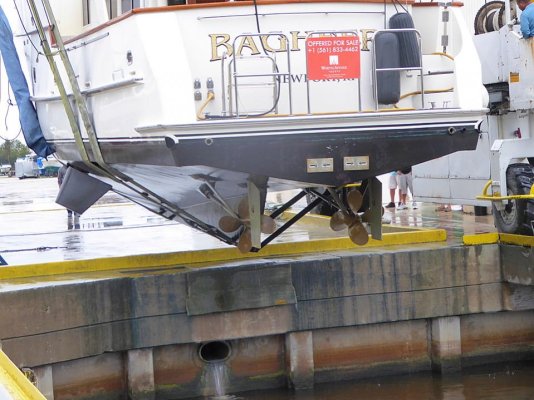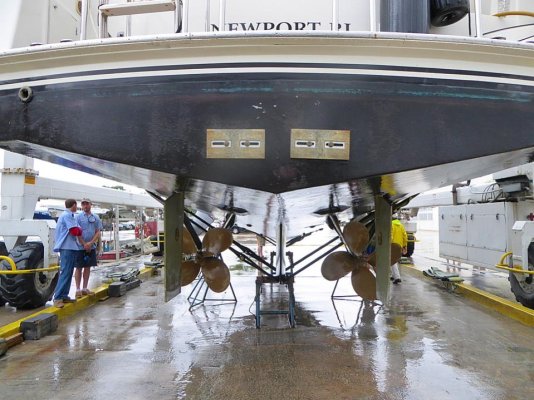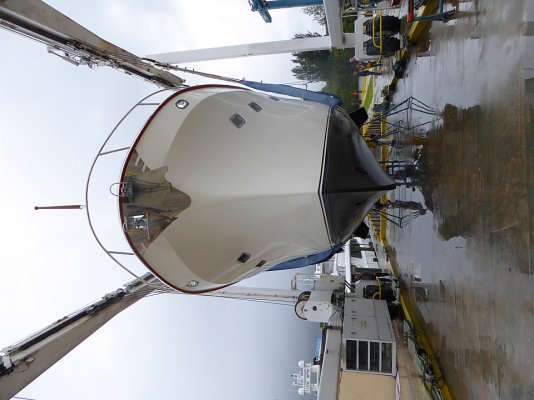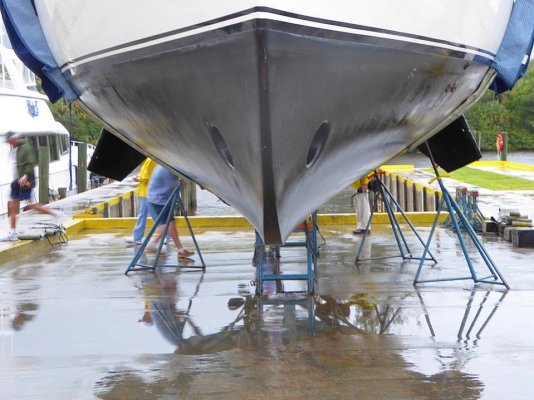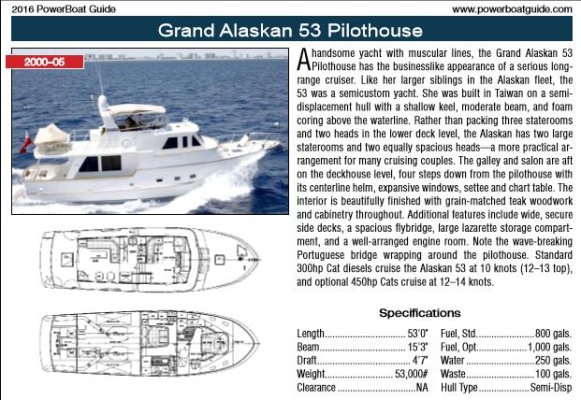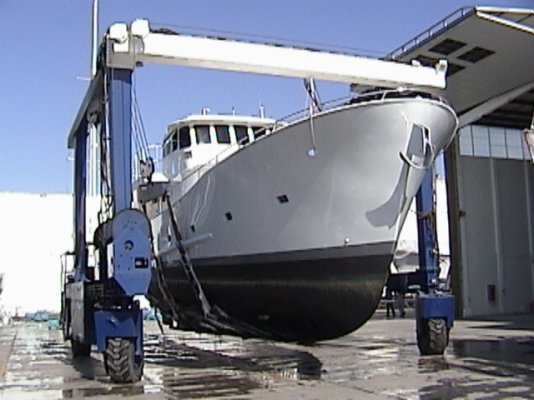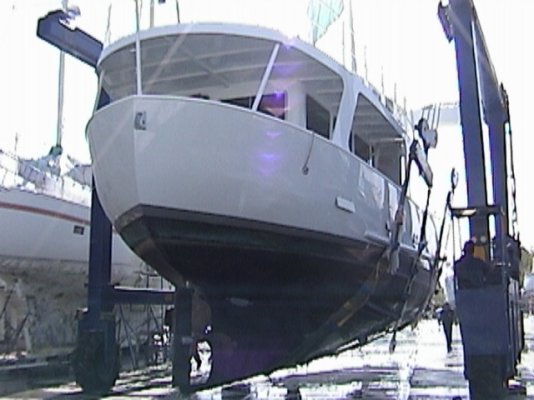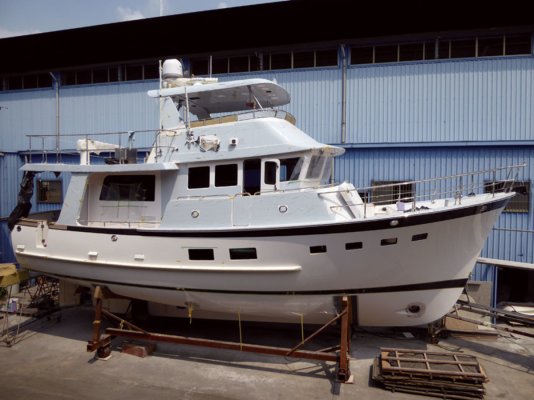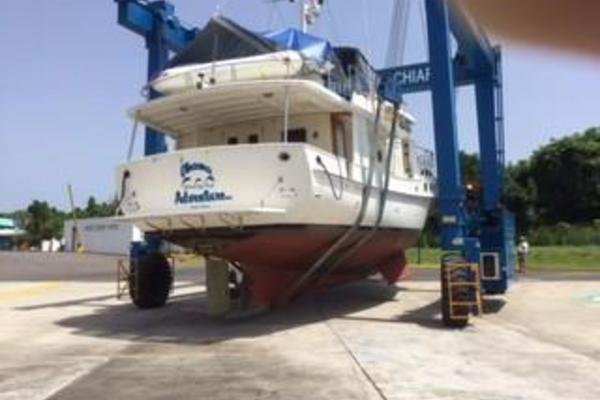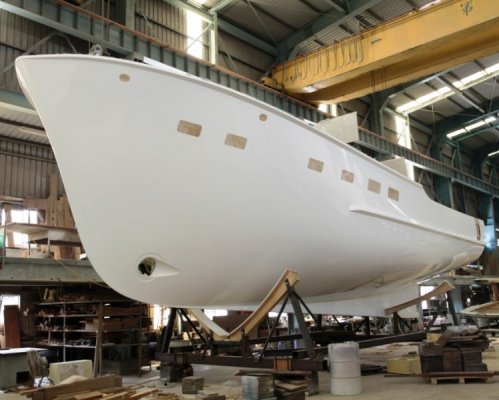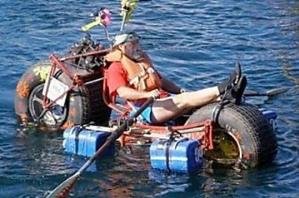You make a valid point Eric and in many ways I agree. Original downeast style boats were much more like what I believe we'd agree is a SD hull and over the years speed has taken precedence over seakeeping. Some of the older style boats were great seaboats with a nice ride while newer ones are too flat to provide either, but they do carry a lot of traps and go fast these days. That's why I prefer hulls like yours and mine, no pretense just a good solid seaboat.
You are using an out of date browser. It may not display this or other websites correctly.
You should upgrade or use an alternative browser.
You should upgrade or use an alternative browser.
Definition Of Full Displacement
- Thread starter menzies
- Start date
The friendliest place on the web for anyone who enjoys boating.
If you have answers, please help by responding to the unanswered posts.
If you have answers, please help by responding to the unanswered posts.
Nomad Willy
Guru
Delfin wrote;
“This illustrates the point that if you put enough power in a semi displacement hull, it will plane”
That depends on what SD hull you’re talking about. For those that are close to planing hulls definitely so. But those SD hulls that often get called FD (like some DeFevers) it’s easy to make the mistake in the other direction. And any boat w a noticeable amount of rocker would suck her stern down and point her bow high in the air if you attempted to run her at planing speeds. NT 32 is probably in this catergory. If you changed your statement to say that “some” SD boats will plane you’d be absolutely correct.
“This illustrates the point that if you put enough power in a semi displacement hull, it will plane”
That depends on what SD hull you’re talking about. For those that are close to planing hulls definitely so. But those SD hulls that often get called FD (like some DeFevers) it’s easy to make the mistake in the other direction. And any boat w a noticeable amount of rocker would suck her stern down and point her bow high in the air if you attempted to run her at planing speeds. NT 32 is probably in this catergory. If you changed your statement to say that “some” SD boats will plane you’d be absolutely correct.
menzies
Guru
I think, but not sure that my GA is "seen" as a SD but there is no way on God's green earth that it is getting over it's bow wave. At WOT with a following wind and current I have seen 11kts, a bit more heading north in the Stream. But that is on the GPS (speed over ground) I rarely look at the B&G wheel speed for speed through water.
Nomad Willy
Guru
Greetings,
All this "discussion" about full displacement and NOT one comment about what anchor is best for said, as yet undefined, vessel...Just sayin'...

Somebody is asleep at the switch.
Ahh I see your post RT.
But I know of no anchor that is FD.
Of course they’re all “fd” once they are submerged. Hmmm
But If I was to guess I’d say a Navy, a Dreadnought or stockless anchors mostly found on ships.
Nomad Willy
Guru
I think, but not sure that my GA is "seen" as a SD but there is no way on God's green earth that it is getting over it's bow wave. At WOT with a following wind and current I have seen 11kts, a bit more heading north in the Stream. But that is on the GPS (speed over ground) I rarely look at the B&G wheel speed for speed through water.
Do you have a picture of the underwater part of her stern?
Hard to imagine your GB as a SD but the hull shape says all.
She probably has a high enough QBBL to classify her as FD.
Delfin
Grand Vizier
- Joined
- Jan 20, 2010
- Messages
- 3,822
If you'd read correctly I clearly stated "race" lobsterboats do 70kts. I thought you also claimed FD hulls could plane so to you FD, SD and planing hulls are all one in the same only segregated by the HP employed?
If you'd read correctly you'd see I wrote exactly the opposite. About 10 times. Like here, and I've bolded the bit I am referring to so it is easier for you to read and understand.
I think it's fair to say that a semi displacement boat that lacks the power to plane becomes a planing hull if you increase the power sufficiently. Unlike a displacement hull, which, as Outer Reef notes, "can never plane."
But Fish, if you want to say that a lobster boat moving through the water at 40 knots or 70 knots is not on plane, have at it.
menzies
Guru
Do you have a picture of the underwater part of her stern?
Hard to imagine your GB as a SD but the hull shape says all.
She probably has a high enough QBBL to classify her as FD.
Grand Alaskan, not Grand Banks.
Attachments
Last edited:
Delfin
Grand Vizier
- Joined
- Jan 20, 2010
- Messages
- 3,822
Do you have a picture of the underwater part of her stern?
Hard to imagine your GB as a SD but the hull shape says all.
She probably has a high enough QBBL to classify her as FD.
They are SD, but GA doesn't seem to put particularly large engines in them, at least on the older ones. They do list max cruise speed above hull speed, which I think tells the tale.
Attachments
Last edited:
That is just another way of saying that for a vessel to plane or get ahead of its own bow wave, lift must exceed drag. You're simply identifying that propulsive power is what causes lift to exceed drag, but that doesn't negate that physical reality.
I disagree with just about everything in that post (#56) but I'll just say this: we must have common terms or we are sunk
You'd have to agree that a nearly submerged sphere is a "displacement" shape? And a submerged sphere is nearly unique in that it produces essentially no lift. Do you doubt that I can tow one at many times faster than 1.34 x diameter ^ 0.5? All that will happen is the stern wave will be well behind the sphere, and it will require a lot of power. This is an existence proof of a displacement shape exceeding hull speed that you can do yourself.
I don't think 10,000 hp is going to do it for Delphin - that's why I suggested 100,000
"Semi Displacement" is as much a marketing term as anything. All boats are semi displacement in that they all create some lift and they all displace some water. Arguing about whether certain hulls are semi displacement or planing has no resolution. The best marketing definition would be a hull intended and powered to operate a significant amount of time in both displacement and planing regimes.
Of course, a larger anchor will result in more displacement. There, I got anchors into the thread.
Of course, a larger anchor will result in more displacement. There, I got anchors into the thread.
Delfin
Grand Vizier
- Joined
- Jan 20, 2010
- Messages
- 3,822
That is what it looks like to me as well. Since SD boats have flat after sections, if you put enough hp in those hulls, they'll plane, so at that point, aren't they planing hulls? If so, it makes the distinction between SD and Planing kind of meaningless."Semi Displacement" is as much a marketing term as anything.
Delfin
Grand Vizier
- Joined
- Jan 20, 2010
- Messages
- 3,822
Perhaps my comprehension has been hampered by your abstruseness?
When offering an insult, it is always better to choose the appropriate pejorative so you don't look like a dope. If I am abstruse, then I am hard to understand, or obscure. Since my comments are easily understandable if read, I think what you wanted to say was that I am obtuse, which would mean I am stupid, not inscrutable. I guess you could mean I am abtuse, which means I am simultaneously abstract and obtuse, which is kind of difficult to achieve since being abstract would seem to imply complexity beyond the reach of the stupid. I'd stick with obtuse. More direct.
I'm going to take a shot at clarification. According to Dave Gerr a well known naval architect and author of numerous books on the subject a semidisplacement hull is one that is "designed to operate above SL ratios of 1.3 or 1.4 but below SL ratios of 2.5 to 3.0". Please note the word "designed" rather than actual speed produced by excessive horsepower to exceed an SL of 3.0 or insufficient horsepower to attain SL of 1.3. Hence regardless of performance it is the designers desire for a particular operating speed range that determines a SD hull and is determined by the hulls designed buttock angle. This reference can be found in the "Propeller Handbook" on page 12 along with a more detailed discussion on this subject.
menzies
Guru
So based on the piece that Delphin posted, if the formulaic hull speed is 10kts, and it cruises (with the 450s) at 13, what the hell does that 3 knots do - certainly not taking it over the bow wave - maybe pushing it at extreme cost? No?
Nomad Willy
Guru
Grand Alaskan, not Grand Banks.
Menzies definitely SD.
I used GB as I know they are but most importantly few here would know what a GA was. This in not a brand specific forum.
Last edited:
psneeld
Guru
Does everyone think all hull shapes clearly fall into one of 3 categories?
All those that know better should not let those trying to "fit" absolute definitions into the discussion sway them and read technical white papers on the subject....and with those often in disagreement....form your own opinion.
There are hulls that clearly fit the 3 descriptions because of hull designs that clearly fit the loose description of FD, SDP, and planing... but a huge amount of hulls fall somewhere in between those loose definitions.
And many professional discussions discuss just that.
All those that know better should not let those trying to "fit" absolute definitions into the discussion sway them and read technical white papers on the subject....and with those often in disagreement....form your own opinion.
There are hulls that clearly fit the 3 descriptions because of hull designs that clearly fit the loose description of FD, SDP, and planing... but a huge amount of hulls fall somewhere in between those loose definitions.
And many professional discussions discuss just that.
Delfin
Grand Vizier
- Joined
- Jan 20, 2010
- Messages
- 3,822
Bit hard to visualize how towing a sphere relates to a displacement hull under its own power. I suppose if I hooked Delfin up to the USS Ronald Reagan while under full power, she'd exceed hull speed, although as has happened to sailboats under tow, likely she would be pulled under water. She'd also exceed hull speed if she was mounted on a flat bed and driven down the road, but I think we're talking about a vessel under its own power in these discussions.I disagree with just about everything in that post (#56) but I'll just say this: we must have common terms or we are sunk. Whether lift exceeds drag or not has nothing to do with speed. Lift and drag are orthogonal vectors on a boat. Lift is up, drag is back (thrust forward, weight down). Lift definitely reduces the displacement of a planing boat (planing is here a verb not a noun), as Archimedes would agree. Planing is not required to exceed "hull speed", it just reduces the power required to do so.
You'd have to agree that a nearly submerged sphere is a "displacement" shape? And a submerged sphere is nearly unique in that it produces essentially no lift. Do you doubt that I can tow one at many times faster than 1.34 x diameter ^ 0.5? All that will happen is the stern wave will be well behind the sphere, and it will require a lot of power. This is an existence proof of a displacement shape exceeding hull speed that you can do yourself.
I don't think 10,000 hp is going to do it for Delphin - that's why I suggested 100,000.
Be that as it may, I agree with NAs like Gerr that full displacement hulls are not designed to provide hydrodynamic lift. They may still generate some, but if full displacement, not enough to offset drag. Absent lift, you have a maximum hull speed where drag simply increases as you power the vessel faster. You disagree, which is fine, but I don't think the physics supports your position.
Delfin
Grand Vizier
- Joined
- Jan 20, 2010
- Messages
- 3,822
So based on the piece that Delphin posted, if the formulaic hull speed is 10kts, and it cruises (with the 450s) at 13, what the hell does that 3 knots do - certainly not taking it over the bow wave - maybe pushing it at extreme cost? No?
The flat sections in the stern generate increasing lift the faster you go, so the 3 knots translates to sufficient lift to keep the stern afloat and get the vessel on top of its bow wave (a bit), further reducing drag (a bit). At the cost of a hellacious amount of fuel.
Comparing your underbody to Delfin's, you can see that my boat has basically no surface under the water that can generate vertical lift. At the bow, the hull is effectively vertical, so no lift can be generated there. In the stern, a bit might be provided at the turn of the bilge, but not much. As Psneed suggests, the lines between hull type classification are fuzzy, but fuzzy or not, some hulls are definitively full displacement, and some are definitively planing. In between are shades of grey where some underbodies have flatter sections and some less. With sufficient area of flat sections to provide lift to offset drag, whether the boat is SD or planing seems to be a matter of how much hp you apply to propulsion. Enough propulsion and the lift generated by flat sections increases, decreasing the power required to keep the vessel on plane.
Attachments
Here’s an article by Kady Krogen: “Spelling-out the Full Displacement Hull”
Spelling-out the Full Displacement Hull Form
Spelling-out the Full Displacement Hull Form
Delfin
Grand Vizier
- Joined
- Jan 20, 2010
- Messages
- 3,822
Nomad Willy
Guru
The Krogen in 110 shows how the percent of submerged transom definition I mentioned some time ago is imperfect. But the Quarter Bean Buttock Line saves the day. There are not many FD boats that have submerged transoms but this is one.
In the photos it’s easy to see the difference between between menzies V bottomed hull and the KK. Lots of rocker over most all the KK’s length.
In the photos it’s easy to see the difference between between menzies V bottomed hull and the KK. Lots of rocker over most all the KK’s length.
RT Firefly
Enigma
Greetings,
A bumble bee isn't supposed to fly based on "calculations", yet it does. There are a plethora of flying objects that also fly regardless of their shape. I suspect it is similar to a "full displacement vessel" not being able to plane.



and, of course...

Even the term "full displacement" is vague IMO.
A bumble bee isn't supposed to fly based on "calculations", yet it does. There are a plethora of flying objects that also fly regardless of their shape. I suspect it is similar to a "full displacement vessel" not being able to plane.



and, of course...

Even the term "full displacement" is vague IMO.
FoxtrotCharlie
Guru
Hey guys, a boat is a boat. Everyone loves their own boat. Lets let this thread pass into the night - lets talk about something benign like anchors 

RT Firefly
Enigma
Greetings,
Mr. FC. I tried to derail the thread in my post #84 but...

Mr. FC. I tried to derail the thread in my post #84 but...

menzies
Guru
Hey guys, a boat is a boat. Everyone loves their own boat. Lets let this thread pass into the night - lets talk about something benign like anchors
I don't think we were talking about particular member's boats, just what makes one over the other. I am sure there are plenty on here who wouldn't want a FD and others the same for SD or Planing.
So it in't a case of "everyone loving their own boat," or even preferring it to others. Just what the heck do "people" mean when they describe one. And who are these "people" anyway!
Nomad Willy
Guru
Foxy Charlie who gave you the authority to end threads?
RT,
The boats and the birds eh
And Fox re anchors I still haven’t tested several anchors but it seems nobody is very interested. But I’ll prolly dump it on ya anyway but no promises when.
RT,
The boats and the birds eh
And Fox re anchors I still haven’t tested several anchors but it seems nobody is very interested. But I’ll prolly dump it on ya anyway but no promises when.
Nomad Willy
Guru
Over here I would say most FD boats have submerged transoms
Fery few have submerged transoms IMO.
What boats would that be? An old GB? They are SD to be sure. Some of the finest FD boats on the planet are represented in Voyaging Under Power. Steven Seaton and Chuck Neville offer wonderful FD designs w more than a tad bit of transom submerged. I love their designs (especially those by Neville) and nobody would mistake them for SD. They are deep and heavy boats and have a fairly steep QBBL ... the bottom aft.
But perhaps there’s some interesting designs down under that most of us are not privy to.
Similar threads
- Replies
- 97
- Views
- 10K

